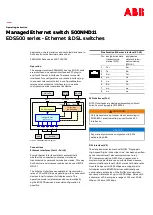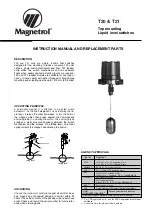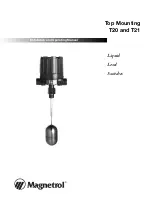
Chapter 5
| VLAN Configuration
IEEE 802.1Q Tunneling
– 168 –
Layer 2 Flow for Packets Coming into a Tunnel Access Port
A QinQ tunnel port may receive either tagged or untagged packets. No matter how
many tags the incoming packet has, it is treated as tagged packet.
The ingress process does source and destination lookups. If both lookups are
successful, the ingress process writes the packet to memory. Then the egress
process transmits the packet. Packets entering a QinQ tunnel port are processed in
the following manner:
1.
An SPVLAN tag is added to all outbound packets on the SPVLAN interface, no
matter how many tags they already have. The switch constructs and inserts the
outer tag (SPVLAN) into the packet based on the default VLAN ID and Tag
Protocol Identifier (TPID, that is, the ether-type of the tag), unless otherwise
defined as described under
“Creating CVLAN to SPVLAN Mapping Entries” on
. The priority of the inner tag is copied to the outer tag if it is a tagged
or priority tagged packet.
2.
After successful source and destination lookup, the ingress process sends the
packet to the switching process with two tags. If the incoming packet is
untagged, the outer tag is an SPVLAN tag, and the inner tag is a dummy tag
(8100 0000). If the incoming packet is tagged, the outer tag is an SPVLAN tag,
and the inner tag is a CVLAN tag.
3.
After packet classification through the switching process, the packet is written
to memory with one tag (an outer tag) or with two tags (both an outer tag and
inner tag).
4.
The switch sends the packet to the proper egress port.
5.
If the egress port is an untagged member of the SPVLAN, the outer tag will be
stripped. If it is a tagged member, the outgoing packets will have two tags.
Layer 2 Flow for Packets Coming into a Tunnel Uplink Port
An uplink port receives one of the following packets:
◆
Untagged
◆
One tag (CVLAN or SPVLAN)
◆
Double tag (CVLAN + SPVLAN)
The ingress process does source and destination lookups. If both lookups are
successful, the ingress process writes the packet to memory. Then the egress
process transmits the packet. Packets entering a QinQ uplink port are processed in
the following manner:
1.
If incoming packets are untagged, the PVID VLAN native tag is added.
Содержание GTL-2881
Страница 30: ...Figures 30 Figure 450 Showing RIP Peer Information 669 Figure 451 Resetting RIP Statistics 670 ...
Страница 34: ...Section I Getting Started 34 ...
Страница 48: ...Section II Web Configuration 48 Unicast Routing on page 651 ...
Страница 151: ...Chapter 4 Interface Configuration VLAN Trunking 151 Figure 69 Configuring VLAN Trunking ...
Страница 152: ...Chapter 4 Interface Configuration VLAN Trunking 152 ...
Страница 229: ...Chapter 8 Congestion Control Automatic Traffic Control 229 Figure 135 Configuring ATC Interface Attributes ...
Страница 230: ...Chapter 8 Congestion Control Automatic Traffic Control 230 ...
Страница 596: ...Chapter 14 Multicast Filtering Multicast VLAN Registration for IPv6 596 ...
Страница 620: ...Chapter 15 IP Configuration Setting the Switch s IP Address IP Version 6 620 ...
Страница 670: ...Chapter 18 Unicast Routing Configuring the Routing Information Protocol 670 Figure 451 Resetting RIP Statistics ...
Страница 672: ...Section III Appendices 672 ...
Страница 678: ...Appendix A Software Specifications Management Information Bases 678 ...
Страница 688: ...Appendix C License Statement GPL Code Statement Notification of Compliance 688 ...
Страница 696: ...Glossary 696 ...
Страница 706: ...GTL 2881 GTL 2882 E112016 ST R01 ...
















































